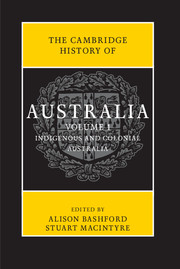Book contents
- Frontmatter
- Contents
- Abbreviations
- List of maps
- List of figures
- List of tables
- Notes on contributors
- Map
- Preface
- Introduction
- PART I
- PART II
- 11 Environmental transformations
- 12 Population and health
- 13 The economy
- 14 Indigenous and settler relations
- 15 Education
- 16 Law and regulation
- 17 Religion
- 18 Colonial science and technology
- 19 Gender and colonial society
- 20 Art and literature: a cosmopolitan culture
- 21 Empire: Australia and ‘Greater Britain’, 1788–1901
- 22 Colonial Australia and the Asia-Pacific region
- 23 The Australian colonies in a maritime world
- Further reading
- Chronology
- Index
- Frontmatter
- Contents
- Abbreviations
- List of maps
- List of figures
- List of tables
- Notes on contributors
- Map
- Preface
- Introduction
- PART I
- PART II
- Further reading
- Chronology
- Index
21 - Empire: Australia and ‘Greater Britain’, 1788–1901
from PART II
Published online by Cambridge University Press: 05 November 2013
- Frontmatter
- Contents
- Abbreviations
- List of maps
- List of figures
- List of tables
- Notes on contributors
- Map
- Preface
- Introduction
- PART I
- PART II
- 11 Environmental transformations
- 12 Population and health
- 13 The economy
- 14 Indigenous and settler relations
- 15 Education
- 16 Law and regulation
- 17 Religion
- 18 Colonial science and technology
- 19 Gender and colonial society
- 20 Art and literature: a cosmopolitan culture
- 21 Empire: Australia and ‘Greater Britain’, 1788–1901
- 22 Colonial Australia and the Asia-Pacific region
- 23 The Australian colonies in a maritime world
- Further reading
- Chronology
- Index
- Frontmatter
- Contents
- Abbreviations
- List of maps
- List of figures
- List of tables
- Notes on contributors
- Map
- Preface
- Introduction
- PART I
- PART II
- Further reading
- Chronology
- Index
Summary
In the Cambridge autumn of 1881, the Regius Professor of History, Sir John Seeley, began a two-part series of lectures to undergraduates on ‘The Expansion of England’, a topic very different from his usual religious and constitutional themes. Seeley's intention was partly to chide his fellow English historians for not paying sufficient attention to the history of Empire: hence his famous, ironic epigram about the Empire having apparently been acquired ‘in a fit of absence of mind’. But more especially he wanted to make a startling assertion about imperial Britain as a state: ‘our Empire is not an empire at all in the ordinary sense of the word’, as he put it. ‘It does not consist of a congress of nations held together by force, but in the main is one nation, as if it were no empire but an ordinary state.’ That ‘Empire’ had increasingly come to mean the settler empire, created through a diaspora of British migrants to major regions like Australasia. It was essentially an ‘intimate and momentous union’. Before globalisation, here was a new style of transnational polity: ‘I mean the simple fact of the extension of the English name into then other countries of the globe, the foundation of Greater Britain’. In such power lay the future of Britain.
This chapter is about Greater Britain and Australian colonisation, and its standpoint is accordingly global. It is no longer possible to write the history of ‘Britain and Australia’ as a singular, dialectical relationship, separate from the wider world of modern history. Colonial Australia was the product of several interrelated ‘revolutions’ – beginning with the geopolitical changes that defined the Western world in the later eighteenth century, together with the American and French revolutions, then extending to transformations brought about by European industrialisation and its effects on international politics in the following century. A mass migration of Britons ultimately underpinned an ‘Anglo-settler revolution’, which formed a ‘Greater Britain’ based on history and ethnicity.
- Type
- Chapter
- Information
- The Cambridge History of Australia , pp. 511 - 534Publisher: Cambridge University PressPrint publication year: 2013
- 2
- Cited by



